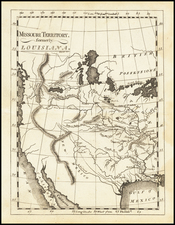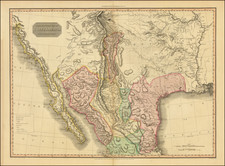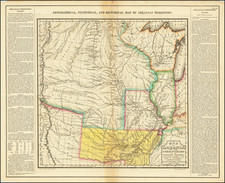Rare early birdseye view of Jackson, Tennesee, by Albert Ruger, the first American Bird's Eye View artist, published in Chicago Lithographing. Co.
Ruger's view of Jackson is one of his earliest printed views we were able to locate, which begin with Ruger's views of Omaha and Nebraska City, issued in 1868. The view is very rare. OCLC locates only the Library of Congress and Penn State copies. The view is very rare, with OCLC locating only the copies in the Library of Congress and Penn State.
The view shows Jackson from the Southeast ("Looking North West") and includes a fine layout of the town, the Mississippi Central Railroad, the Mobile & Ohio Railroad, streets, builidings, etc. A Reference Key locates nearly 30 places, including Schools, Churches, the court house and West Tennessee College.
Albert Ruger was the first of the bird's eye artists active in America. As noted by the Library of Congress:
Albert Ruger was the first to achieve success as a panoramic artist. The collections of the Library's Geography and Map Division contain 213 city maps drawn or published by Ruger or by Ruger & Stoner. The majority came from Ruger's personal collection, which the Library purchased in 1941 from John Ramsey of Canton, Ohio. Before this accession, there were only four Ruger city plans in the Geography and Map Division. Born in Prussia in 1829, Ruger emigrated to the United States and worked initially as a mason. While serving with the Ohio Volunteers during the Civil War, he drew views of Union campsites, among them Camp Chase in Ohio and Stephenson's Depot in Virginia. He continued to draw after the war, and his prints include a famous lithograph of Lincoln's funeral car passing the statehouse in Columbus, Ohio.
By 1866, Ruger had settled in Battle Creek, Michigan, where he began his prolific panoramic mapping career by sketching Michigan cities. Full descriptions of many Ruger views of Michigan cities are contained in John Cumming's A Preliminary Checklist of 19th Century Lithographs of Michigan Cities and Towns. Urban communities in some twenty-two states and Canada, ranging from New Hampshire to Minnesota and south to Georgia and Alabama, were sketched by Ruger. He continued his activity into the 1890s, moving his business to Chicago, Madison, and St. Louis as he sought new markets. In the late 1860s, Ruger formed a partnership with J. J. Stoner of Madison, Wisconsin, and together they published numerous city panoramas. Ruger was particularly productive during the 1860s; in 1869 alone, he produced more than sixty panoramic maps. In addition to city plans, he drew views of university campuses, among them Notre Dame, Shurtleff College, and the University of Michigan. Albert Ruger died in Akron, Ohio, on November 12, 1899.
Settlement of Jackson began along the Forked Deer River before 1820. Originally named Alexandria, the city was renamed in 1822 to honor then General Andrew Jackson, who would later be elected President. The City of Jackson was founded in 1821, in the same year of the creation of Madison Country. Jackson became the Seat of Justice for the County. Most settlers at that time were living on Cotton Grove Road.
During the Civil War, between December 11, 1862 and January 1, 1863, an engagement at Jackson occurred during Confederate Brigadier General Nathan Bedford Forrest's expedition into West Tennessee. Forrest unsuccessfully attempted to disrupt the rail supply line to Ulysses S. Grant's army, campaigning down the Mississippi Central Railroad.
The following is excerpted from the Library of Congrss Website:
Albert Ruger was the first to achieve success as a panoramic artist. The collections of the Library's Geography and Map Division contain 213 city maps drawn or published by Ruger or by Ruger & Stoner. The majority came from Ruger's personal collection, which the Library purchased in 1941 from John Ramsey of Canton, Ohio. Before this accession, there were only four Ruger city plans in the Geography and Map Division. Born in Prussia in 1829, Ruger emigrated to the United States and worked initially as a mason. While serving with the Ohio Volunteers during the Civil War, he drew views of Union campsites, among them Camp Chase in Ohio and Stephenson's Depot in Virginia. He continued to draw after the war, and his prints include a famous lithograph of Lincoln's funeral car passing the statehouse in Columbus, Ohio.
By 1866, Ruger had settled in Battle Creek, Michigan, where he began his prolific panoramic mapping career by sketching Michigan cities. Full descriptions of many Ruger views of Michigan cities are contained in John Cumming's A Preliminary Checklist of 19th Century Lithographs of Michigan Cities and Towns. Urban communities in some twenty-two states and Canada, ranging from New Hampshire to Minnesota and south to Georgia and Alabama, were sketched by Ruger. He continued his activity into the 1890s, moving his business to Chicago, Madison, and St. Louis as he sought new markets. In the late 1860s, Ruger formed a partnership with J. J. Stoner of Madison, Wisconsin, and together they published numerous city panoramas. Ruger was particularly productive during the 1860s; in 1869 alone, he produced more than sixty panoramic maps. In addition to city plans, he drew views of university campuses, among them Notre Dame, Shurtleff College, and the University of Michigan. Albert Ruger died in Akron, Ohio, on November 12, 1899.












![[ Southern Railroads ] Railroad Map of the Southern States Shewing the Southern & Southwestern Railway Connections With Philadelphia. 1862 . . . Prepared by Thomas Kimber Jr., Chairman of the Committee on Inland Transportation of the Board of Trade of Philadelphia](https://storage.googleapis.com/raremaps/img/small/103211.jpg)
![[Hand Drawn Map] Le Golfe de Mexique avec les Pays Circonvoisins](https://storage.googleapis.com/raremaps/img/small/91580.jpg)
![[Report and] Map of an Exploring Expedition to The Rocky Mountains in the Years 1842 and to Oregon & North California in the Years 1843-44 By Brevet Capt. J. C. Fremont of the Corps of Topographical Engineers . . .](https://storage.googleapis.com/raremaps/img/small/88488.jpg)